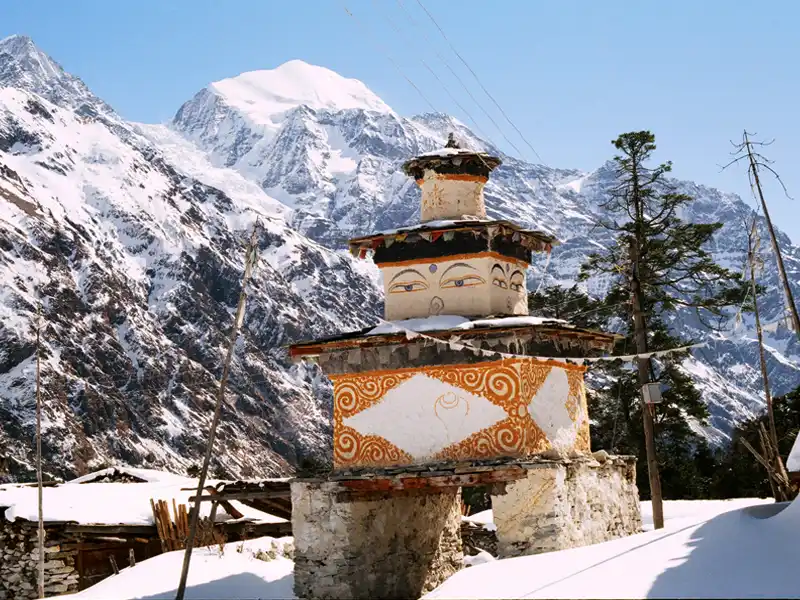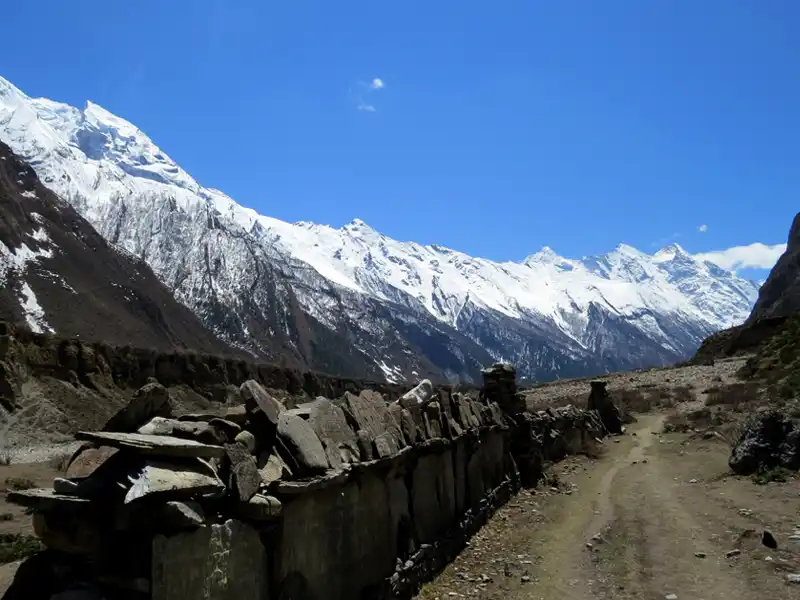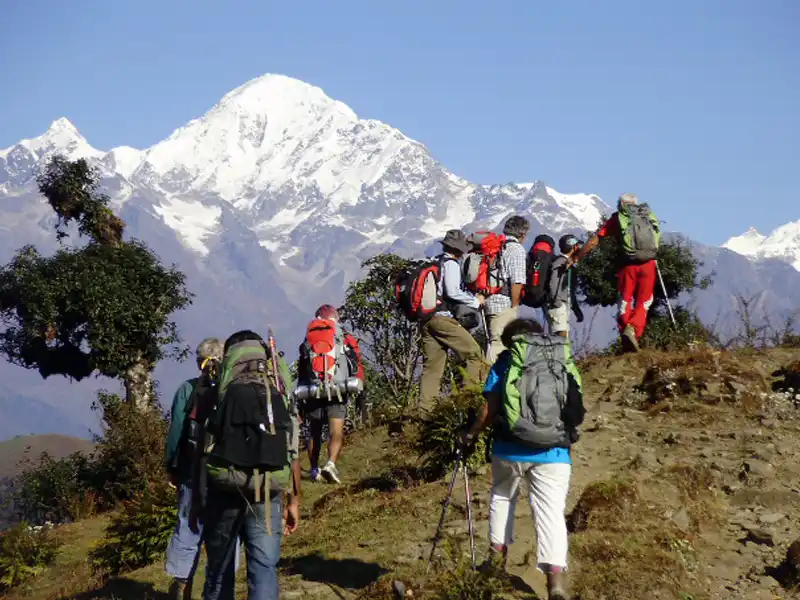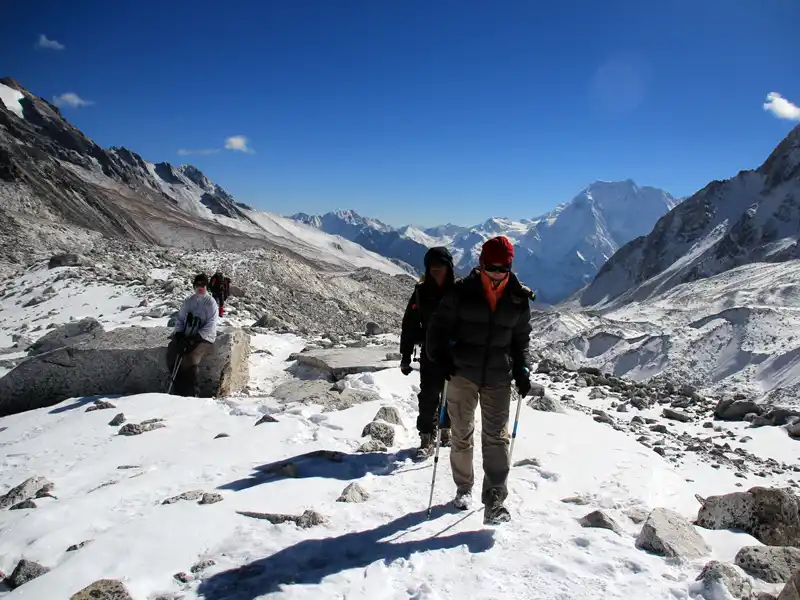A representative from Manaslu Tours will welcome you upon your arrival in Kathmandu and drive you to your hotel. To start your journey on a high note, we will host a welcome dinner in the evening featuring authentic Nepalese cuisine and a warm welcome drink.
- SWOYAMBHUNATH , also referred to as the monkey temple, is accessible by a steep set of steps and offers stunning views of Kathmandu.
- BOUDHANATH STUPA has many traditional gompas hung with strings of multi-colored prayer flags; it attracts many Sherpas and Tibetans for the circumambulations of the stupa (koras).
- PASHUPATINATH is a Hindu temple with burning ghats on the banks of the Bagmati River.
- KATHMANDU DURBAR SQUARE, which is one of the old capitals of the Kathmandu valley, has a blend of Hindu and Buddhist temples
After a nutritious breakfast, set off on a 5-hour drive to Gorkha Bazar. During the journey, marvel at the picturesque landscapes, cross over sparkling streams, and follow the winding banks of the Darundi Khola. In the evening, embark on an excursion to the historic Gorkha Durbar on a hilltop. From this vantage point, take in panoramic mountain views and bask in the warm glow of a breathtaking sunset.
After having a big breakfast this morning, embark on a trek to Barpak. Drive along the Darundi Khola and Ranglung Khola to reach the village. The drive from Ranglung Khola to Barpak is steep, but the destination is worth it. Barpak is a stunning village on a green ridge with stunning views of the misty valley below. You might be able to attend a cultural performance in the evening that the villagers have organized, with the proceeds going toward improving the village. The towering Bouddha Himal, a high snow-capped peak, provides a beautiful backdrop for sunrise and sunset photos.
Start the day early with a scenic climb up the narrow ridge, with Bouddha Himal providing a magnificent backdrop to the sprawling Barpak. After an hour or so of trekking, take a small stone trail to the right of the main path. After three hours of climbing, reach Momche Dada (2,950m), a pass that separates Laprak and Barpak. The summit offers breathtaking panoramic mountain views, including Bouddha Himal, Sringi Himal, Ganesh Himal, Langtang Range, and sheep grazing on the grassy hillsides. During the spring, the surrounding rhododendrons bloom brilliantly in various hues of pink and red, making for great photos with the snow-capped peaks in the background. Another hour or two of steep descent leads to another large Gurung village, Laprak. Spend the afternoon exploring the village, including walking down the hill and viewing the houses with their symbolic mud-brick murals.
We traverse Laprak's maze of village paths and reach the Jyabru Khola. After crossing a suspension bridge, we ascend steeply and pass terraced fields of pink sorghum. The narrow trail, often obscured, winds around hillsides and leads us to a small chorten below the village of Singla. From here, the hike becomes more accessible, and we are treated to views of the Kutang Himal and Sringi Himal to the north. Our path continues through more terraced fields and papaya trees, through the Gurung village of Khorla, before winding down to Khorlebeshi on the Budhi Gandaki River. Take caution on the rocky steps before the long suspension bridge to Khorlabeshi. Be mindful of the local women weaving straw mats in the village. In the evening, we may receive a visit from the village's cultural ambassadors and experience another performance.
Today, we have a five-hour trek ahead. We'll start by walking along the river, surrounded by tobacco and buckwheat fields, and admiring rocks smoothed by the river's flow. Our journey will involve climbing stone steps to reach the hot springs in the terraced village of Tatopani. Here, we can soak our weary bodies in the hot water and swim in the nearby icy river. After drying off on the lovely riverside beach, we'll gently hike through the woods to a spectacular waterfall. We'll cross an old wooden suspension bridge and continue through a short forest path to Dovan. Above Dovan, the Budi Gandaki River presents steep rapids. Our trail will take us high above the river and gently down through calmer water. We'll cross the river on a long, new suspension bridge and climb stone steps to reach our camp below Jagat, the Manaslu Conservation National Park entrance. Before heading to camp, please take a moment to wander around the beautiful, paved village of Jagat and admire the pride of the villagers who have recorded their contributions to the paving projects.
After descending a long series of stone steps from Jagat to the river, we climb up beautiful stone steps along a terraced hillside to reach the tiny hamlet of Salleri. From here, we are treated to an impressive view of the Sringi Himal, which is 7,187m tall. Our journey takes us through the picturesque and paved village of Sirdibas. We cross the river again at Ghata Khola on a long, high-suspension bridge. The path splits, with the right branch leading towards the Ganesh Himal. Our route continues upstream with a steep climb to Philim. We first cross the river at a narrow gorge section using a new suspension bridge and then ascend gradually along a broad hillside through an open forest. Using a small bridge, we will cross the river two more times in the next two hours. The first bridge is located at the intersection of Tsum Valley, a remote valley leading to Tibet.
Descend into a gorgeous forest, crossing three streams via bridges. Circle under a towering river bluff and ascend steeply on sturdy but exposed stairs. After approximately 30 minutes, traverse north through pine trees and rhododendrons, continuing to climb with very steep inclines. Ahead lies the alluring hidden valley of Tsum. Finally, descend to the isolated Ghumlong (2,130m) on the river. The path ahead climbs steeply to Ripchet (2,470m) in about an hour, while the path to Chumling (2,360m) crosses the Shiar Khola on a wooden bridge and ascends. After about 30 minutes near Chumling, the trail takes a level route to the right (east) for 15 minutes to reach the final hotel in Tsum. In the evening, visit the old monastery, traditional houses, orchards, clinic, and beautiful stone streets. This is an agricultural area where Buddhism is practiced, with conical haystacks made of pine needles among prayer flags. From here, trails are lined with decorative chortens and mani walls made of thousands of stone slabs engraved with deities and prayers.
Head east and cross a suspension bridge to journey through fertile farmland filled with maize and potatoes. Along the way, you will come across a massive landslide that has cleared an area to the opposite bank, now covered in a forest of young trees with stunning views of Mt. Ganesh Himal. Continue your journey by crossing the Serpu Khola and climbing a well-graded but exposed track for 2.5 hours to reach the upper Tsum and the large village of Chhokangparo (3,010m), where you'll find stone houses tucked under cliffs, with not a single iron roof in sight. The valley opens into vast fields of barley, maize, buckwheat, and potatoes, with herds of Thar often grazing on the rugged cliffs to the north. You can catch an impressive view of Mt. Himalchuli (7,893m) from the fields in the valley.
Journey east through quaint villages and a local school, trek over a ridge dotted with chortens, and past Lamagaon (3,202m) through flat fields with expansive crops and a river view of the grand Rachen Gompa (3,240m). Hike up to Milarepa's Cave (Piren Phu), where the famous Tibetan Buddhist teacher is said to have meditated. The cave is undergoing restoration. Cross the Shiar Khola, pass by the hamlets of Phurbe (3,251m) and Pangdun (3,258m) and an unusual round stupa before reaching the larger village of Chhule (3347m) with a distinctive entrance gate. The children here wear traditional Tibetan chubas, and many yaks are in the area. Continue upstream to cross the bridge and hike to the Nile (3,361m). These villages feature traditional designs with livestock compounds integrated into homes and sheltered verandahs for drying crops. However, the cold weather makes staying in people's houses uncomfortable, and there needs to be more privacy.
The trail from the Nile gradually rises to reach Mu Gumba, the largest and highest monastery in the Tsum Valley. Established in 1895 AD, Mu Gumba is located at an altitude of 3700m. It houses important religious texts, including the Kangyur, a life-sized statue of Avalokiteshwara, and images of Guru Padmasambhava and Tara. The historic Dephyudonma Gumba is one of the oldest monasteries in the Tsum Valley, located in rugged mountains and reachable by a 2-hour walk from the villages of Chhule and Nile. The monastery's founder, Lama Serap of Nile Ladrang from the Kangin sect, has a strong connection to the beginning of Buddhism in the valley. There are a few camping sites and drinking water sources available.
From Mu Gumba, the trail leads to Rachen Gumba, a nunnery located in the Shiar Khola Valley at the foothills of the Nepal-Tibet border. Established in 1905 AD, Rachen Gumba is one of the largest nunneries in the Tsum Valley and is home to nuns from the Ngak-pa sect who observe a vegetarian lifestyle. The nunnery boasts one thousand clay statues of Avalokiteshwara, a beautifully carved throne and pillar, and a large prayer wheel. The interior is adorned with richly painted murals depicting Buddhist history and teachings.
Descend a narrow trail along the Shiar Khola and cross the bridge to reach Dhumje (2,440m), a village with a Tibetan herbal medicine clinic and school. Climb steeply on a rugged trail through pine and rhododendron forests until you reach a mani wall with prayer flags. The trail is narrow and exposed but eventually leads to Gumba Lungdang (3,200m), a small nunnery perched on a ridge surrounded by beautiful rhododendrons. With 40 nuns in residence, the gompa offers intense worship from 6:00–7:30 pm each night and boasts stunning mountain views in all directions. Our nine trips to Nepal highlight this as the absolute highlight.
Cross the Laudang Khola over a wooden bridge to the west bank and ascend through a forest of pines and rhododendrons on a ridge. There's a hut halfway up, and the track continues behind it, then up a dry creek bed with birch trees. The climb leads to grassy flats behind the Toro Gompa glacier's lateral moraine, with seasonal yak huts and a track with views of the surrounding mountains. The Ganesh Himal Base Camp (4200m) is reached in about 4 hours. The map shows another base camp on the east side of the glacier, but no obvious track connects them. Retrace your steps to Gumba Lungdang for the evening puja. Despite the altitude, the unspoiled forest and views make this trip remarkable.
Start early, as today may be demanding. Take the upward track from Gumba Lungdang and cross Laudang Khola, staying on the south bank of Shiar Khola. Navigate through deep gorges and shaky bridges to reach Ripchet (2,470m), a picturesque valley of barley and buckwheat with chortens in the fields surrounded by pine forests. Descend the steep stairs to Ghumlong (2,130m), a lone lodge on the river that passed six days ago. Climb through the temperate forest to reach Lokpa (2,240m) and stay in a comfortable lodge there.
The trek from Lokpa to Tatopani (a hot spring) takes 7 to 8 hours and primarily consists of a descent. Upon arrival, soothe your weary muscles in the hot spring and rejuvenate after several days of hiking.
Today, we traverse terraced fields and encounter tropical waterfalls flowing from towering cliffs and rivers rushing through steep gorges. We will set up camp at Soti Khola, a Gurung village, marking the end of our trekking journey. Celebrate this final day with your trekking crew.
As per your preference or the advice of your trekking guide, we'll be ready for breakfast at 6:00 a.m. The return journey to Kathmandu will be by road, passing through picturesque terraced fields, streams, rivers, charming local villages, and hilly terrain. The bus or Jeep ride is estimated to take 6 to 7 hours and will bring you back to your hotel in Kathmandu. However, please note that the duration of the journey may vary depending on the road conditions.
Today, we have a free day to explore the vibrant city of Kathmandu on our own. You may want to spend the day indulging in some souvenir shopping, wandering around the colorful streets and bazaars, or enjoying the local cuisine. You could also visit some of the popular tourist attractions in the city, such as Bhaktapur or Patan, which showcase Nepal's rich cultural and historical heritage. Alternatively, you could engage in other activities like hiking, biking, or adventure sports, or relax and rejuvenate in one of the city's many spas and wellness centers. Whatever you choose to do, make sure to soak up the unique sights, sounds, and flavors of this beautiful city.
Today, we will transfer to Kathmandu International Airport for our departure. After enjoying a hearty breakfast at the hotel, we will gather our belongings and go to the airport. We will ensure we reach the airport in time to complete all the necessary formalities and board our flight. Before we bid farewell to this enchanting country, take one last look at the breathtaking views of the Himalayas and take a moment to appreciate the warm hospitality and kindness of the Nepalese people. This marks the end of our tour, and we hope you had a memorable and enjoyable time in Nepal.
The Tsum Valley Trek cost on the website applies to groups of 6–12 people. However, private trips for groups of two or more can be organized upon request. A group booking of 12 or more people can offer a maximum discount with one free trip. Clients' travel date preferences can be accommodated, but the trek cost depends on group size, duration, accommodation type, and additional activities or services.
- Group Size: The cost of the trip will depend on the size of the group.
- Hotel Accommodation Category and Client's Budget: The cost may also vary based on the accommodation category and budget preference of the client.
- Itinerary Modification: Our trekking itinerary can be modified according to your time and requirements, and the cost will be adjusted accordingly.
- Additional Services: If you require additional services, the cost will be adjusted accordingly based on mutual understanding.
- Trekking Staff: The cost is also affected by the number of Trekking Guides, Assistant Guides, and extra porters required for the trip.
Please feel free to reach out to us with any questions or to book your trek.
| Trip Dates | Trip Cost | Status | Inquiry |
| March 12 - April 01, 2024 | USD USD 2,000.00 | Available | Inquiry |
| April 10 - April 30, 2024 | USD USD 2,000.00 | Available | Inquiry |
| April 25 - May 15, 2024 | USD USD 2,000.00 | Available | Inquiry |
Cost Includes:
- Airport pick-up and drop services in private transportation before and after the trek.
- Hotel Accommodation: 4 Nights in Kathmandu at a twin sharing room on BB plan.
- City Cultural Tour in Kathmandu with City Tour Guide and all the entrance and monument fees.
- Transportation: Kathmandu - Barpak and Soti Khola - Kathmandu with Nepalese crew.
- Breakfast, Lunch, and Dinner during Tsum Valley Trek.
- Best available tea-house or lodge at twin-sharing room for accommodation during the trek.
- Trekking Staffs: Well-experienced English-speaking Trekking Guide, Assistant Guide for a group of over 6 people and Porters (2:1) including their daily allowance, meal, and accommodation.
- Accidental and medical insurance for Nepalese team.
- Trekking Permits: Special permit of Tsum Valley, and Manaslu Conservation Area Project (MCAP) Entry Permit fee.
- All government applicable taxes
- Travel agency service charge.
Cost Excludes:
- Lunch and dinner in Kathmandu before and after Tsum Valley Trek.
- International air ticket.
- Beverage and hard drinks and alcohol.
- Nepal entry visa fee and airport tax during the departure.
- Extra supporting staff, laundry, battery charge, and communication expenses.
- Personal expenses like tea, coffee, bar bill, drinking water, beverage, snacks, hot shower, etc.
- Travel and medical insurance, emergency evacuation/natural disaster, or personal reasons.
- In any case of natural calamities, mishaps, or anything beyond our control.
- Tips and gratitude for the Nepalese Trekking crews.
Please feel free for any queries.
Q: What is the Tsum Valley Trek?
A: The Tsum Valley Trek is a culturally rich and relatively less-traveled trek in the Manaslu region of Nepal. It takes you through the picturesque Tsum Valley, known for its Tibetan-influenced culture and traditions.
Q: How long is the Tsum Valley Trek?
A: The Tsum Valley Trek is typically completed in 17-20 days, depending on the itinerary and acclimatization schedule.
Q: What is the best time to go on the Tsum Valley Trek?
A: The best time to go on the Tsum Valley Trek is in the spring (March to May) and autumn (September to November) when the weather is dry, and the skies are clear.
Q: What is the difficulty level of the Tsum Valley Trek?
A: The Tsum Valley Trek is a moderate trek that requires a moderate level of fitness and endurance. The trek involves some steep ascents and descents, and the highest point on the trek is Mu Gompa at 3,700 meters.
Q: Is a permit required for the Tsum Valley Trek?
A: Yes, a permit is required for the Tsum Valley Trek. The trek falls under the restricted area, and a special permit is required, which can only be obtained through a registered trekking agency.
Q: What kind of accommodation is available on the Tsum Valley Trek?
A: The accommodation on the Tsum Valley Trek ranges from basic tea houses to homestays. The tea houses are simple but clean, and the rooms are generally shared. Homestays provide a more authentic experience and are an excellent opportunity to interact with the locals and learn about their culture and traditions.
Q: What are the highlights of the Tsum Valley Trek?
A: The highlights of the Tsum Valley Trek include exploring the picturesque Tsum Valley, visiting ancient monasteries, interacting with the locals, and experiencing their unique culture and traditions. The trek also provides stunning views of snow-capped mountains, including Manaslu and Ganesh Himal, and the opportunity to see diverse flora and fauna.
 Tsum Valley Trekking
Tsum Valley Trekking Most Popular
Most Popular 


